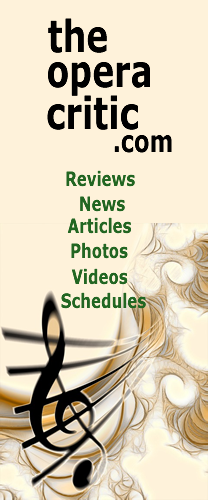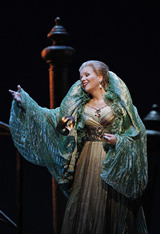| Opera Reviews | 18 April 2024 |
A musical treasure chestby Michael J. Vaughn |
|
| Donizetti: Lucrezia Borgia San Francisco Opera 26 September 2011 |
|
|
This was especially evident in the first-act "Com' è bello!" an aria sung to her sleeping son Gennaro (who does not know that he is her son). But the artfulness went on all night - for instance, an incredibly gradual crescendo that rises into a riotous chorus later in the act. Twenty years after her SFO debut, Fleming is at the top of her game, and it is an utter joy to watch her cast her spells. Not that she's alone. SFO has assembled a cast of one divine bel canto voice after another, beginning with tenor Michael Fabiano as Gennaro. Elizabeth DeShong brings a forceful, vibrant mezzo to the pants role of Gennaro's warrior-lover Orsini; their third-act duet, with its extended passages of unaccompanied harmonizing, are breathtaking. Another treat is bass Vitalij Kowaljow, a powerful, sinister Duke Alfonso who cuts through the orchestra with his assertive, forward-placed tone. Musically, this less-performed opera provides some fascinating moments, including a trio for Gennaro, Alfonso and Lucrezia that prefigures devices used by Verdi. Torn between her son and her husband (who assumes Gennaro to be his wife's lover), Lucrezia's vocal line flies back and forth between the two like a tennis ball. It's also a great pleasure to hear the composer's use of Gennaro's warriors, akin to having a small men's chorus. Dramatically, the opera provides a challenge similar to another recent SFO opera, Puccini's Turandot: a heroine who also happens to be a mass murderer. The trick is to understand the mythologizing process of the era, which often fell prey to misogyny: in this case, in blaming Lucrezia for the sins of her family. Donizetti clearly allows for this possibility, using Victor Hugo's empathetic play as his source material, and creating the kind of music that could only serve to soften the historical view of Lucrezia. It's also intriguing to note the parallels (mistaking a child for a lover, killing a child in a bungled attempt at revenge), in a previous Hugo play, Le Roi S'Amuse, the source for Verdi's Rigoletto. The vision of a woman dressed as a man kissing a man (dressed as a man) is a bit of pseudo-homerotica rare even for San Francisco. Another unsettling vision is created by the device used for Lucrezia's throat-slicing suicide, a knife blade that spouts blood. John Pascoe's production design is both authentic - the series of Italian limestone walls and facades that shuffle into the opera's different settings - and fantastical - costumery that takes medieval Italian styles and push them in the direction of fantasy-fiction comic books. Alfonso projects his wicked aura with a black leather robe and crown. Lucrezia turns up in Act III as something akin to Brünnhilde meets Wonder Woman (a testament to Fleming's well-known workout regimen). The only misfire was with Orsini, whose leggings do nothing to hide Ms. DeShong's womanly hips (while her gruff red beard butches her up quite a bit). Conductor Riccardo Frizza guided his orchestra like a man opening a musical treasure chest on Christmas morning. He showed great care in giving his lead singers room to operate. |
|
| Michael J. Vaughn is a twenty-five year opera critic. You can find excerpts from his latest novel under the Facebook fan page Operaville. | |
| Text ©
Michael J. Vaughn Photos © Cory Weaver |

 Renée
Fleming's cadenza are so gorgeously crafted that the true aficionado
may forget there's some kind of opera going on. She manages to deliver
these small treasures without sounding the least bit canary-like, and
sings so effortlessly that they seem more like conversations that have
taken flight.
Renée
Fleming's cadenza are so gorgeously crafted that the true aficionado
may forget there's some kind of opera going on. She manages to deliver
these small treasures without sounding the least bit canary-like, and
sings so effortlessly that they seem more like conversations that have
taken flight. 





